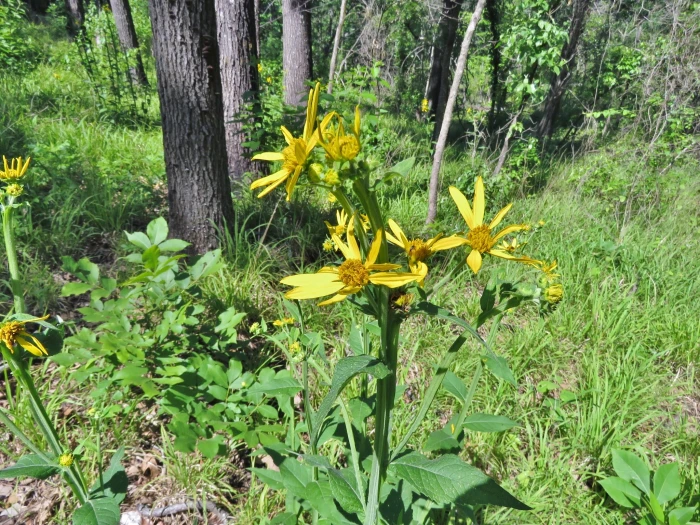Yellow Crownbeard
(Verbesina helianthoides)
Yellow Crownbeard (Verbesina helianthoides)
/
/

Annika Lindqvist
CC BY 4.0
Image By:
Annika Lindqvist
Recorded By:
Copyright:
CC BY 4.0
Copyright Notice:
Photo by: Annika Lindqvist | License Type: CC BY 4.0 | License URL: http://creativecommons.org/licenses/by/4.0/ | Rights Holder: Annika Lindqvist | Publisher: iNaturalist | Date Created: 2017-05-13T10:40:25-07:00 |
























Estimated Native Range
Climate Requirements for Bayamón, Puerto Rico
| This Plant | Your Site | Plant Suitability for Your Location | ||
|---|---|---|---|---|
| • Precipitation | 17" - 108" | 72" | Aquatic | Aquatic |
| • High Temp. | 70°F - 96°F | 91°F | Your summer temperatures are normal for this plant. | Excellent |
| • Low Temp. | 8°F - 64°F | 66°F | OK, but your winter temperatures are warmer than normal for this plant | OK |
This plant may not grow well at your location - your precipitation is too high.
Summary
Verbesina helianthoides, commonly known as Yellow Crownbeard, is a deciduous perennial herb native to open woodlands, forest edges, and prairies in the Southcentral United States. It typically grows to a height of 2-3 feet (0.6-0.9 meters) and a width of 1-2 feet (0.3-0.6 meters). The plant features lanceolate leaves and clusters of bright yellow, daisy-like flowers with a long blooming season from May to October, which is notably earlier than other Verbesina species in its range.
Yellow Crownbeard is valued for its extended flowering period, providing a splash of color in the garden for much of the growing season. It is used in wildflower gardens, as a border plant, and in naturalized areas where its low water requirements and adaptability to various soil conditions are advantageous. It thrives in full sun but can tolerate partial shade and prefers soils with medium drainage. While generally low-maintenance, it can be susceptible to powdery mildew in humid conditions. This plant is also beneficial to pollinators, attracting bees and butterflies.CC BY-SA 4.0
Yellow Crownbeard is valued for its extended flowering period, providing a splash of color in the garden for much of the growing season. It is used in wildflower gardens, as a border plant, and in naturalized areas where its low water requirements and adaptability to various soil conditions are advantageous. It thrives in full sun but can tolerate partial shade and prefers soils with medium drainage. While generally low-maintenance, it can be susceptible to powdery mildew in humid conditions. This plant is also beneficial to pollinators, attracting bees and butterflies.CC BY-SA 4.0
Plant Description
- Plant Type: Herb
- Height: 2-3 feet
- Width: 1-2 feet
- Growth Rate: Moderate
- Flower Color: Yellow
- Flowering Season: Summer
- Leaf Retention: Deciduous
Growth Requirements
- Sun: Full Sun
- Water: Medium
- Drainage: Medium
Common Uses
Bee Garden, Bird Garden, Butterfly Garden, Deer Resistant, Drought Tolerant, Erosion Control, Hummingbird Garden, Low Maintenance, Rabbit Resistant, Showy Flowers
Natural Habitat
native to open woodlands, forest edges, and prairies in the Southcentral United States
Other Names
Common Names: Yellow Crownbeard
Scientific Names: Verbesina helianthoides, Actinomeris helianthoides, Actinomeris helianthoides var. elliotii, Actinomeris elliotii, Actinomeris helianthoides var. helianthoides, Actinomeris helianthoides var. nuttallii, Phaethusa helianthoides, Pterophyton helianthoides
GBIF Accepted Name: Verbesina helianthoides Michx.